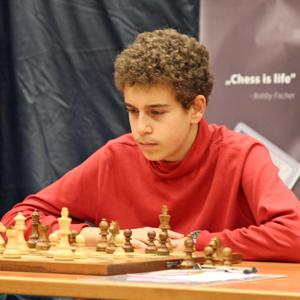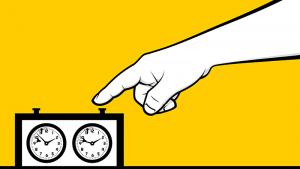
Introduction to My Friday Columns
Hello everyone! It is an honor and a pleasure to be the new Friday columnist for Chess.com. Chess and writing are two of my greatest passions, and I am very excited to be able to combine them on a weekly basis. I cannot wait to start analyzing games and tackling the topical issues of modern chess, but I think an introductory article is in order.
My first chess memories are actually quite vivid. I remember learning the rules of the game from my brother at age six, and losing game after game in similar fashion (1.e4 a5 2.Bc4 a4 3.Qf3 and now I tried almost every move in the position besides 3...e6 or 3...Nf6). Every day after school, we would rush upstairs, set up the pieces, and play for hours on end.
At first chess was nothing but a pleasant diversion, but as I improved and our games became more competitive, Lego and Monopoly began to seem rather boring in comparison. On the weekends, my dad would read a Russian translation of Capablanca's Chess Fundamentals aloud to us, and I was spellbound by every word. Chess is an unexplored world, a bloodless war, an infinitely complex mental and psychological challenge. Put simply, I was ensnared.

The key to my initial success consisted in the nature of my early chess studies. By the time I was a class C player, I had read My System, Chess Fundamentals, Lasker's Manual of Chess, and Bronstein's Zurich 1953. To be sure, my opening knowledge was scant, but my chess foundation was sound. Here is a case in point:
My "positional sacrifice" on move 16 was easily refutable, but this game still taught me a crucial lesson: irrespective of your opening knowledge and tactical vision, positional understanding and endgame technique will bring you many, many extra points.
After becoming an Expert in February 2006, I encountered my first major obstacle. 2004 and 2005 were golden years: I won two Nationals, brought my rating up 200 points, and was convinced that climbing the ladder to National Master and beyond was going to be as easy as beating Denver in this year's Superbowl (perhaps non-sports fans should forget about my column here and now!).
After floundering around 2050 for six months, I finally diagnosed my main weakness: my positional understanding was suffering from gross neglect. Sure, my knowledge of blockade and overprotection and exchange sacrifices was enough to push me to a certain level, but Caissa does not reward laziness! Riding the waves of success, I shifted my focus to online bullet games and fun tactical exercises, forgetting all about positional training and opening work in the process.
In September of 2006, I opened a blank notebook and began chronicling my positional work. Coming from the mouth of a ten-year-old boy with no front teeth, the end goal of producing a 250+ page diary of positional improvement seemed rather ambitious, but I was determined. By immersing myself in writing and working toward a clearly-defined goal, I not only saw momentous improvement in my chess results, but also understood what it means to truly study chess. The following game, played in November 2006, convinced me that I was not writing in vain.
The culmination of my efforts came the following November, when I won the under-12 World Youth Chess Championship in Antalya, Turkey. Put simply, I was in a mega-zone -- there was no position I was incapable of winning, no opponent who dented my confidence, and no opportunity I failed to pounce on. I had never before experienced such a "natural cerebral high," as GM Walter Browne phrases it in his autobiography. I ended the tournament with nine wins, one draw, and one loss -- Antalya was a surreal experience I will never forget!
Upon returning home, I completed my "diary" and decided to type up the handwritten manuscript. It had always been my dream to write a chess book, and I saw no reason to believe that other players would not benefit from my learning experiences. In addition, digitizing the manuscript (since I tackled positional concepts one-by-one, it was already divided into chapters) allowed me to walk the very same road that brought me out of the doldrums one year earlier. My games were no longer all-or-nothing propositions; positional mistakes and juvenile blunders certainly still occurred, but I started to consistently outplay my opponents on both a tactical and a positional front.
For the second time in my chess career, I went from zenith to nadir in an instant. After reaching 2382 FIDE (in October 2008) and coming close to IM norms in several tournaments, I became totally confident in my ability to secure the IM title within a year. My ego ballooned as well: I began keeping an "IM Watch" (updates of the rating points and norms required to earn the title) on and grew alarmingly lackadaisical in my chess studies. Of course, in perfect hindsight, such naivety appears inexplicable, but I was simply too full of myself to study! I performed disgracefully at the 2008 World Youth Chess Championship in Vung Tau, Vietnam, and by January 2010, my rating had dropped a devastating 50 points.
George Bernard Shaw once quipped that "those who cannot change their minds cannot change anything." I am tempted to say that I woke up one rainy Sunday morning and heeded his warning, but the healing process was a far slower and more agonizing process. Eventually, I came to an interesting and perhaps controversial conclusion: at times, it is crucial to seek motivation and confidence not only in one's general improvement curve, but in individual games. I will illustrate with an example.

In July 2009, I played in the LCT Open in Leiden, the Netherlands. In round five, I managed to defeat Ukrainian GM Yuri Vovk with a flashy middlegame combination. This was my first win against a grandmaster, and while the immediate euphoria was washed away by two painful losses in the subsequent rounds, a spark of inspiration remained. A few months later, I revisited that fleeting elation -- a brief but intense feeling of confidence. To be sure, I thoroughly analyzed the objective causes of my downturn, but I also picked up on a general lethargy that penetrated almost all of my games. Slowly but steadily, I started to rediscover the luster that pervaded my games from 2006 and 2007. I might have been a weaker player back then, but I was also a more determined, more energetic player. I no longer focused on mechanically applying concepts to my games and calculating my rating change after every win or loss, but rather concentrated on creating, as Russians put it. In one tournament alone -- the 2010 Golden State Open -- I produced two combinations that I am proud of to this day. Here is one of them:
The IM title came soon enough. Mastering Positional Chess was published by New in Chess in March 2010, and I earned my first IM norm four months later at the First Saturday Tournament in Budapest, Hungary. The second and third norms came soon after at the Groningen Chess Festival in the Netherlands and the Berkeley International in California. By early 2011, I was, at long last, an International Master.
The two-and-a-half year road to the Grandmaster title was no less treacherous, but a bit less eventful. Although my rating remained constant for most of the time, I could feel myself improving with every passing tournament. The jump from IM to GM did not require any significant changes -- I needed to eradicate several prominent weaknesses in my play, but I never doubted my ability to break through. As I came to realize, hard work does not guarantee immediate success; improvement is a rather amorphous concept and sometimes the minutest changes in your mindset or playing style can pay immense dividends the very next tournament!
In April 2013, I secured my second GM norm by tying for first at the Philadelphia Open, but I certainly cannot ascribe this success to any heavy-duty chess work (in fact, I flew to Philadelphia right after taking a math test in school!). I merely strengthened my opening repertoire with both colors and became a tad more aggressive. Tiny improvements -- opening work here, endgame work there -- might take months to show themselves on the board, but there is no such thing as futile work.
After winning the U.S. Junior Closed Championship in July 2013, I traveled to Spain for two large open tournaments. One solid performance later (at the Vila de Benasque Open, incidentally the tournament in which I earned my first GM norm two years earlier), I was a Grandmaster. It is always quite pleasant to fulfill a lifelong dream (a jaw-dropping statement, I know), but hopefully my ascension has only begun. In general, I do not like to set rigid goals -- I will simply try my best to keep growing!
I will end with one of my best games to date, played this past August in Riga, Latvia. Hopefully, it is a worthy representation of my chess credo: I am not a tactician or positional player -- I believe that both aspects of the game, like the yin and yang, are inextricably bound together.
After speaking with IM Danny Rensch, I have decided that my first ten or fifteen articles will address strong players' ability to successfully break general chess principles. How do grandmasters know when it is permissible to weaken a square or leave a piece undeveloped? When can we move a piece twice in the opening? I will attempt to explain, both verbally and analytically, how to reconcile the golden rules of one's chess upbringing with modern chess's need for concreteness. Farewell, till next Friday!
Like this article? Help us improve! Chess.com is looking to hire a part-time Assistant Editor to help with all of our content! Interested? Apply here!
RELATED STUDY MATERIAL
- Read Part 1 of IM Jeremy Silman's series The Power of Positional Chess;
- Check out Thomas Wolski's Chess Mentor Build Your Technique;
- Watch GM Alex Lenderman's video Stay Hungry - Part 3: Never Give Up Without a Fight!;
- Sharpen your tactics!

